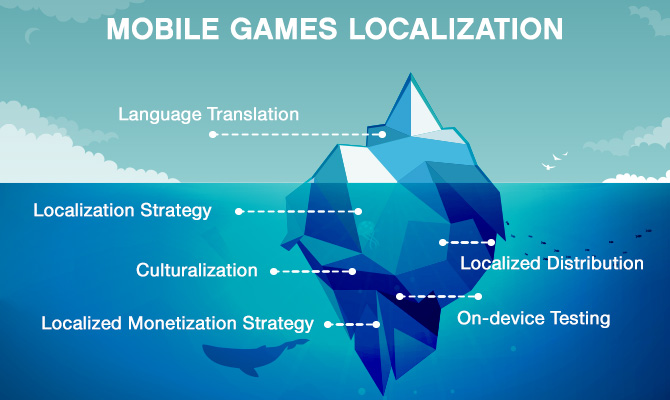According to WSJ, the global mobile game market is expected to increase eightfold from $3.77 billion in 2010 to $29.6 billion in 2017. And among all the countries, the Asia Pacific region, with China and Japan as leaders, is the biggest market for mobile game developers with 48% of the global revenue and three times more paying gamers than the second biggest region, North America.
Considering these statistics, it?EUR(TM)s no surprise that there are countless mobile games trying to expand abroad each year; however, very few can claim success.
Part of the problem is that mobile gaming has become a modern-day gold rush. Worldwide developers flooded the market hoping to strike it rich, making today?EUR(TM)s mobile game market extremely competitive, no matter in domestic or oversea markets.
But the biggest factor is that developers often underestimate the challenges and importance of mobile game localization.
In our experience of helping mobile games go global, here are six common mistakes they make when jumping into the international market. Avoid these, and you will greatly increase your chances of success.

 4. Underestimate the challenge of global mobile game distribution
If you think that all the mobile game distribution channels in every country are similar, you are making a big mistake! In the rush to launch overseas, this is often the most overlooked problem by game developers.
Do you know that China doesn?EUR(TM)t have Google Play? Instead, it has around 200 Android app stores creating a highly fragmented market. Without a system in place to track the performance of these channels, you basically can?EUR(TM)t have accurate strategies for distributing your app in this country.
Each of those app stores serve a different audience with their own characteristics. You need to look at their different behaviours and adapt your games to different situations. For instance, market leaders often create different versions for different app stores. In other words, if there are 20 app stores they want to target, they will create 20 different versions and marketing strategies for their games.
Due to these complexities, many western game developers work with local publishing and localization partners when they are trying to expand to China now.
When your team comes up with the localization strategy plan, make sure to discuss whether a local partner is needed.
5. Failing to localize the monetization strategy
Although your code and content may be the most obvious localization candidates, your revenue model is equally critical.
In some developing countries, like China, their game players don?EUR(TM)t make as much money as the average US gamers. Your business model needs to reflect that reality as a result.
When Plants Vs. Zombies 2 launched in China, they initially tried to optimize for the monetization too much, making the game way too hard and expensive to play, which backfired on user?EUR(TM)s reviews and dropped their rating from five star to two at one point. To overcome this, they learned from the experience and tried to figure out the right balance of difficulty and how to reasonably ask for money by changing the game?EUR(TM)s economy. Now they get far fewer negative reviews than before.
When sharing his learnings at the Game Developers Conference, Leo Liu, GM of EA Mobile in China, said, "The Chinese market is so different, you have to be prepared for anything unusual from the Western perspective.?EUR?
Make sure you won?EUR(TM)t repeat their mistakes.
6. No on-device testing and translation review prior to release
This is an amateur problem that is so easily avoidable and yet we came across it time and time again.
You work so hard on the game, create a great localization plan, translate UI strings, it launches, and suddenly, you realise something is broken. You find out that some extra long German words break some of your game UI! But the worst part of this scenario is when your CEO asks you how this happened, and you say, "I thought the translator was taking care of it?EUR??EUR?
Never assume and never leave anything to chance. At the end of the day, if something does go wrong, and you could have easily prevented it, the responsibility is on you.
Professional translators are human and people make mistakes sometimes, especially in the complex, fragmented and rapidly evolving world of mobile.
Make sure your localization partners provide localization testing and review services on a number of mobile devices because you can?EUR(TM)t afford to disappoint your users with buggy games. After you?EUR(TM)ve received a poor rating, there is no way to hide poor quality in the world of mobile.
Conclusion
It?EUR(TM)s true that international expansion is hard to get right. Therefore, clear ownership, good strategy up-front, and great execution are critical. That way your mobile game will be in a great position to take advantage of the huge international opportunity!
If you want to learn more about whether your mobile games are on the right track in terms of localization strategy, I invite you to get a Free Assessment with our Localization Managers today. We?EUR(TM)re here to help! Simply click the banner below to join the invitation.
4. Underestimate the challenge of global mobile game distribution
If you think that all the mobile game distribution channels in every country are similar, you are making a big mistake! In the rush to launch overseas, this is often the most overlooked problem by game developers.
Do you know that China doesn?EUR(TM)t have Google Play? Instead, it has around 200 Android app stores creating a highly fragmented market. Without a system in place to track the performance of these channels, you basically can?EUR(TM)t have accurate strategies for distributing your app in this country.
Each of those app stores serve a different audience with their own characteristics. You need to look at their different behaviours and adapt your games to different situations. For instance, market leaders often create different versions for different app stores. In other words, if there are 20 app stores they want to target, they will create 20 different versions and marketing strategies for their games.
Due to these complexities, many western game developers work with local publishing and localization partners when they are trying to expand to China now.
When your team comes up with the localization strategy plan, make sure to discuss whether a local partner is needed.
5. Failing to localize the monetization strategy
Although your code and content may be the most obvious localization candidates, your revenue model is equally critical.
In some developing countries, like China, their game players don?EUR(TM)t make as much money as the average US gamers. Your business model needs to reflect that reality as a result.
When Plants Vs. Zombies 2 launched in China, they initially tried to optimize for the monetization too much, making the game way too hard and expensive to play, which backfired on user?EUR(TM)s reviews and dropped their rating from five star to two at one point. To overcome this, they learned from the experience and tried to figure out the right balance of difficulty and how to reasonably ask for money by changing the game?EUR(TM)s economy. Now they get far fewer negative reviews than before.
When sharing his learnings at the Game Developers Conference, Leo Liu, GM of EA Mobile in China, said, "The Chinese market is so different, you have to be prepared for anything unusual from the Western perspective.?EUR?
Make sure you won?EUR(TM)t repeat their mistakes.
6. No on-device testing and translation review prior to release
This is an amateur problem that is so easily avoidable and yet we came across it time and time again.
You work so hard on the game, create a great localization plan, translate UI strings, it launches, and suddenly, you realise something is broken. You find out that some extra long German words break some of your game UI! But the worst part of this scenario is when your CEO asks you how this happened, and you say, "I thought the translator was taking care of it?EUR??EUR?
Never assume and never leave anything to chance. At the end of the day, if something does go wrong, and you could have easily prevented it, the responsibility is on you.
Professional translators are human and people make mistakes sometimes, especially in the complex, fragmented and rapidly evolving world of mobile.
Make sure your localization partners provide localization testing and review services on a number of mobile devices because you can?EUR(TM)t afford to disappoint your users with buggy games. After you?EUR(TM)ve received a poor rating, there is no way to hide poor quality in the world of mobile.
Conclusion
It?EUR(TM)s true that international expansion is hard to get right. Therefore, clear ownership, good strategy up-front, and great execution are critical. That way your mobile game will be in a great position to take advantage of the huge international opportunity!
If you want to learn more about whether your mobile games are on the right track in terms of localization strategy, I invite you to get a Free Assessment with our Localization Managers today. We?EUR(TM)re here to help! Simply click the banner below to join the invitation.
 Note: This article was originally published on the OneSky Localization Blog and is republished here with kind permission of the original author.
Note: This article was originally published on the OneSky Localization Blog and is republished here with kind permission of the original author.




Any tips on how to approach mobile games publishing in China as an indie game studio?